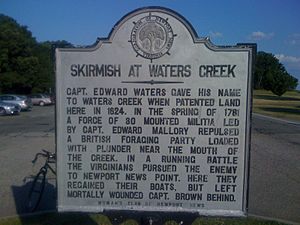Skirmish at Waters Creek facts for kids
Quick facts for kids Skirmish at Waters Creek |
|||||||
|---|---|---|---|---|---|---|---|
| Part of the American Revolutionary War | |||||||
|
The approximate location in the state of Virginia where the skirmish occurred. |
|||||||
|
|||||||
| Belligerents | |||||||
| Commanders and leaders | |||||||
| Francis Mallory † | Thomas Dundas | ||||||
| Strength | |||||||
| c.40 | 300-400 | ||||||
| Casualties and losses | |||||||
| 7 killed 4 captured |
2 killed 2 wounded |
||||||
The Skirmish at Waters Creek was a small battle that happened on March 8, 1781. It was part of the American Revolutionary War. This fight took place near Waters Creek in Newport News, Virginia. It was between local American Patriot soldiers and troops from the British Army.
Why Did the Skirmish Happen?
For most of the American Revolutionary War, the state of Virginia did not see much fighting. This changed in October 1780 when about 2,500 British Army soldiers arrived. These troops were led by Brigadier General Alexander Leslie. They set up a strong base in Portsmouth. From there, they started raiding the area to get supplies.
However, their leader, Lieutenant General Charles, Earl Cornwallis, told them to leave Portsmouth in November. Then, in January 1781, another 1,600 British troops arrived in Virginia. These new troops were led by Benedict Arnold, who had switched sides from the Americans to the British.
Arnold and his men quickly attacked Richmond, the state capital. After this quick attack, they settled down for the winter in Portsmouth.
How Did the Americans Respond?
Local American Patriot soldiers watched Arnold's troops in Portsmouth. They would respond whenever Arnold sent out groups to raid or gather supplies.
On the morning of March 8, Arnold sent about 300 men on a raiding trip. They were heading to the Newport News area. These British troops were led by Lieutenant Colonel Thomas Dundas. His group included soldiers from the Royal Edinburgh Volunteers and a company from John Graves Simcoe's Queen's Rangers.
When the American militia learned about Dundas's plan, Colonel Francis Mallory quickly organized a defense. Mallory lived in Hampton. He had just been released from a British ship where he was held as a prisoner. He had been warned not to fight again.
While he was a prisoner, Mallory learned important information about where the British might go. He used this information to try and set up a surprise attack. He planned to ambush the British at a place called Tompkins' Bridge. This bridge crossed a creek between Hampton and York County.
The Fight at Waters Creek
The American soldiers split their forces for the attack. The cavalry (soldiers on horseback) charged from the front. At the same time, the infantry (soldiers on foot) fired their weapons from the side.
During the fight, Colonel Mallory was badly hurt. He was hit by a shot, a saber, and a bayonet, and he died. Even though their leader was killed, the American soldiers kept fighting. They were able to stop the British forces.
The British troops were forced to retreat back to Newport News point. From there, they eventually got back to their boats and left. During their retreat, a British officer named Captain Brown was injured and left behind.



